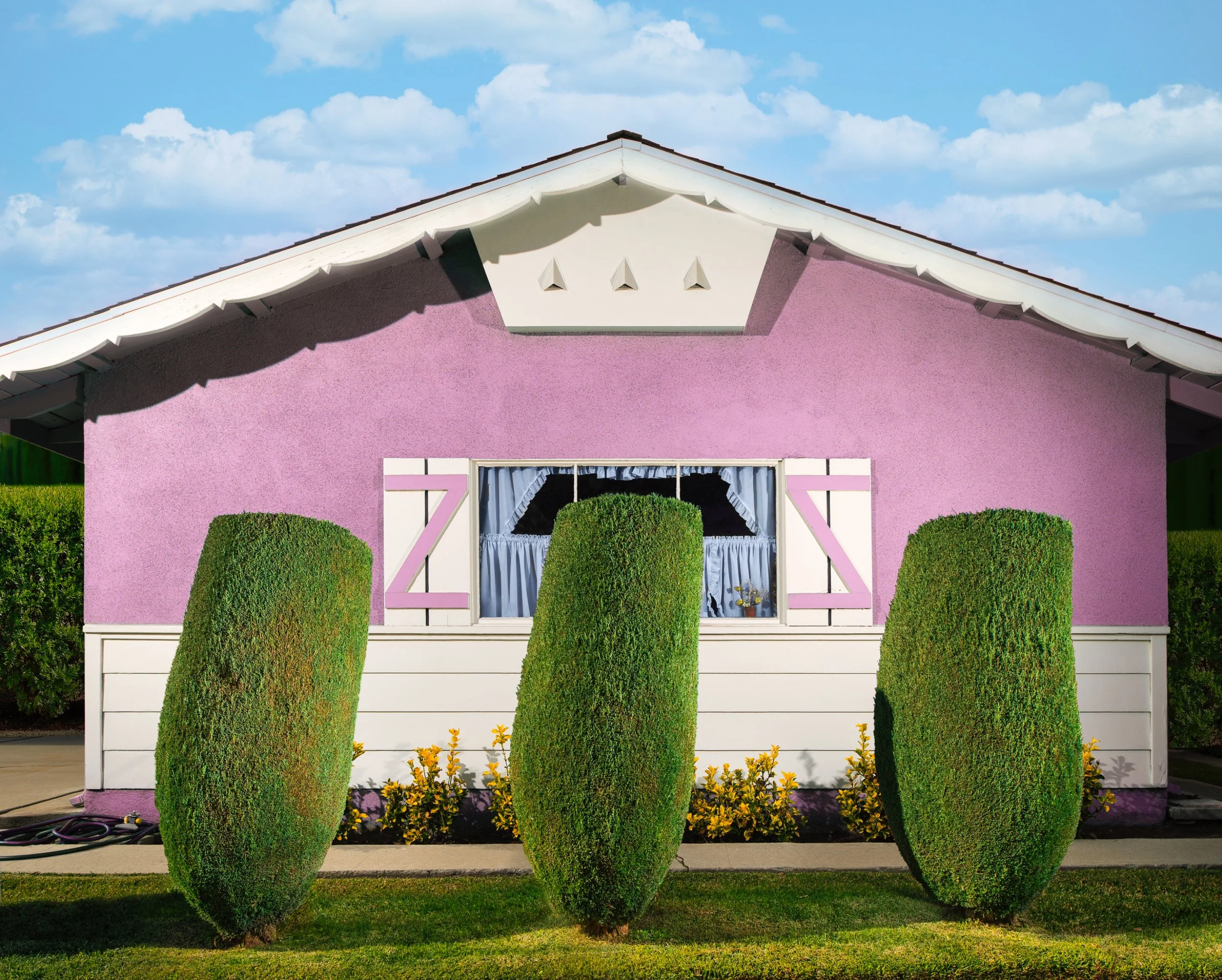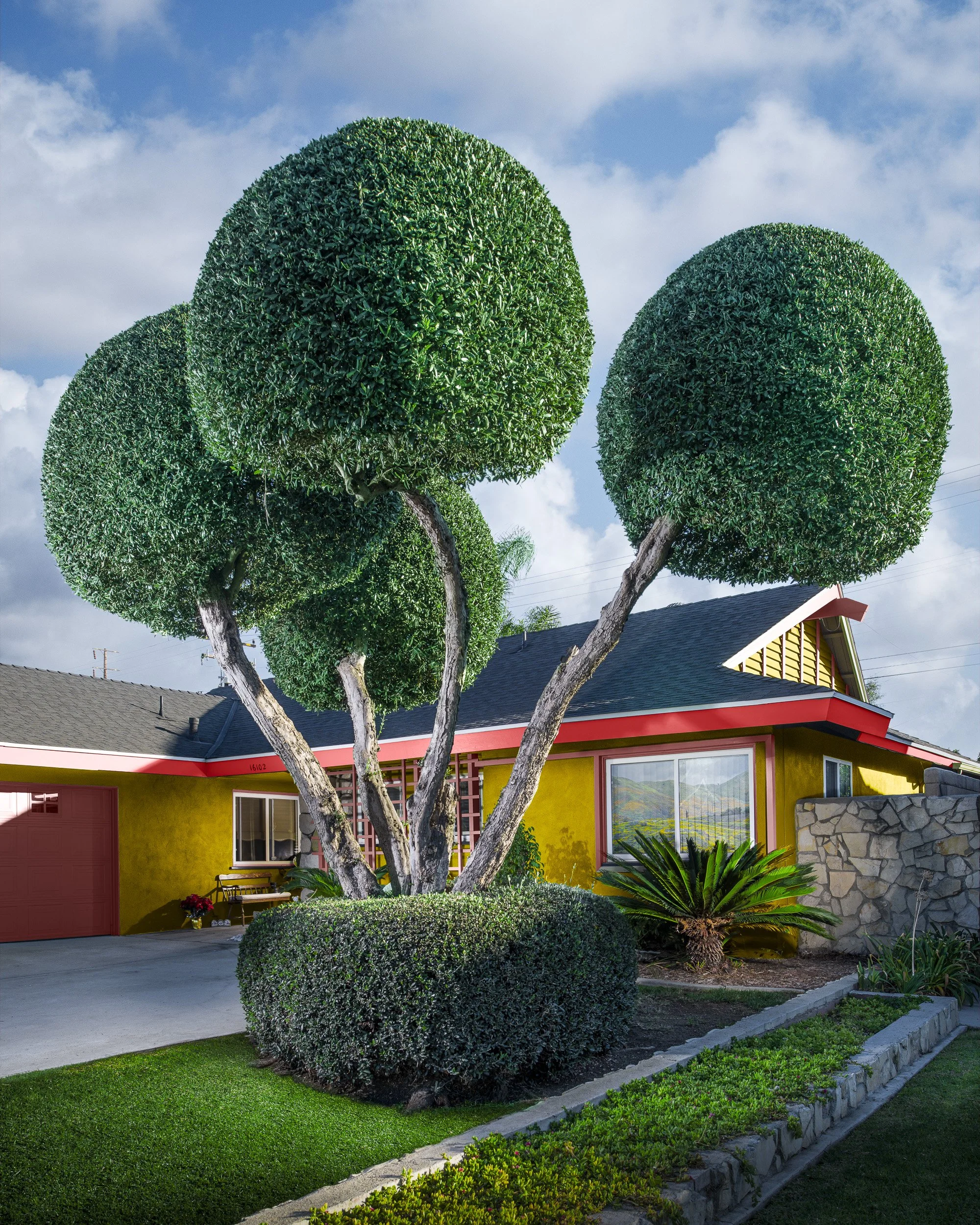PRESS RELEASE: Gardens of Suburban Delight at SPRING/BREAK NYC 2025
John Raymond Mireles, Pink House with Trees, 2016
SPRING/BREAK Art Show Information:
Collector/Press Preview: Tuesday, May 6, 12:00 - 8:00pm
VIP Preview Day: Wednesday, May 7, 12:00pm - 7:00pm
Regular Show Days: May 8-12, 12:00pm - 7:00pm
Location: 75 Varick Street, NYC
FOR IMMEDIATE RELEASE
(NEW YORK) We are thrilled to announce Gardens of Suburban Delight, a curated room for the annual SPRING/BREAK Art Show in New York City. Featuring the bold insightful photography of Los Angeles native John Raymond Mireles, the exhibition will showcase seven photographs from two series— complete with his signature varnish to evoke a ‘painting’ aesthetic— displayed in a booth designed to evoke a ‘perfect’ suburban yard.
No paradise is more ‘earthly’ than the coveted suburban Southern California home and lifestyle. When maintained —according to the mid-20th-century ideals— its distinct, manicured appearance appears as a welcoming, cheerful, and ‘perfect’ facade. Yet, beneath this veneer of reliability and order, there often lies a yearning for creativity, individualism, and a touch of debauchery. Aligned with the fair’s “Paradise Lost/Found” theme, this exhibition derives inspiration from two fantastical cautionary tales: Hieronymus Bosch’s triptych The Garden of Earthly Delights (c. 1490 –1510) and Tim Burton’s film Edward Scissorhands (1990). Mireles’s works reimagine the mundane trappings of suburban life into vibrant, fantasy-laden visions, revealing the contradictions and complexities concealed in Southern California’s sprawling neighborhoods.
In his Neatly Trimmed Bush series, Mireles captures stylized vignettes of suburban homes adorned with sculpted topiaries. Each brightly colored rendition of a ranch-style home radiates whimsical charm. Many of these midcentury homes fall into the fairytale-inspired styles known as ‘Cinderella cottages’ or ‘storybook ranches,’ architectural designs intended to evoke a sense of utopian fantasy amid the relentless conformity of suburban tract life.
However, in Mireles’s photographs, these front yards transcend mere mow and blow maintenance. Here artful suburbanites have turned their gardens into artistic tableaus, transforming ubiquitous boxwoods, ficuses, and cypresses into sculptural masterpieces. Ordinary foliage, such as the cypress in Pink House with Trees (2016), are meticulously clipped, bent, and trimmed—often over years—to form a variety of shapes and geometric topiaries reminiscent of the works of Modernist masters.
Through this transformation, the ‘neatly trimmed bush’ transcends decorative objects serving as a potent symbol of the ‘real’ suburbia — a realm of conformity and order that simultaneously craves free expression and escapism from the very bland. Eye-catching trees, such as the tiered sculpture in Red House with Tree (2009), embody this paradox, injecting whimsy into an otherwise tightly scripted uniformity.
In the film, Edward Scissorhands, the protagonist’s hedge trimming becomes a tool for acceptance, as he uses his creative skill to ingratiate himself with his neighbors despite his otherness. In real-life suburbia, however, the dynamic is reversed. Homeowners use their carefully sculpted bushes to stand out, subtly rebelling against the uniformity that defines their environment. The cultivated garden becomes a quiet but unmistakable rejection of convention.
Mireles’s Subversive series expands this narrative, blending fashion, sexuality, and postwar suburban angst. Here, mid-century tract homes serve as backdrops for provocative portraits of housewives reimagined as pin-up models. Dressed in revealing high-fashion outfits—short skirts, plunging necklines, and stilettos—these women take on unusual chores, such as repairing a muscle car or watering the lawn. While their glamorous attire suggests a bold departure from suburbian norms, their poses and expressions convey a nuanced sense of introspection, blurring the line between empowerment and escapism. Appearing unfocused and detached from their tasks at hand, their frozen appearance singles a shift from reality and into the realm of fantasy.
This series in part draws from Mireles’s own upbringing in suburban Los Angeles within a strict Catholic household. It visualizes the forbidden desires of adolescence, using the suburban home as a stage for repressed fantasies. Like Bosch’s central panel of The Garden of Earthly Delights—depicting a paradise of lovers and unbridled sexual curiosity—Mireles’s work imagines a world unbound by the moral and normative constraints of suburban life. These photographs offer glimpses of ‘delight’ as sinful pleasures conjured from the depths of imagination.
When viewed together, Gardens of Suburban Delight provides visually compelling and psychologically layered insights into the suburban Los Angeles experience. Each work prompts viewers to question our idealized notions of American suburban ‘perfection’ and reflect on how much diversity, individuality, and creativity are needed to forge a vision of ‘paradise’ — whether lost or newly found.
Gardens of Suburbian Delight is curated by Ashley Ouderkirk, and will be on view in Booth B6 at 75 Varick Street in New York City from May 7th to 12th. On Tuesday May 6, a Press Preview + Collector First Look will be held from 12pm - 5pm, followed by a VIP Opening Reception from 5pm - 8pm. Both the artist and curator will be present.
For further information or press inquiries, please contact Ashley Ouderkirk at AshleyLOuderkirk@gmail.com. Artworks will be available to purchase on SPRING/BREAK’s website beginning Tuesday, January 6th.
John Raymond Mireles, Watering, 2008.
John Raymond Mireles, Yellow House with Tree, 2009.



